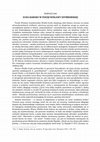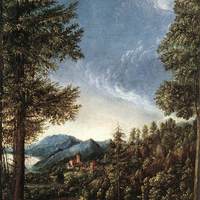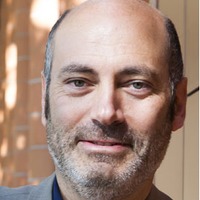Books by Andrzej Lam

Gunther Narr Verlag Tübingen. Deutsche TextBibliothek hrsg. v. Gotthart Wunberg, 1990
Lam, Polonist an der Universität Warschau, beschreibt und kommentiert die kurze intensive Zeitspa... more Lam, Polonist an der Universität Warschau, beschreibt und kommentiert die kurze intensive Zeitspanne der polnischen Avantgarde: Der Expressionismus und der Formismus (1917-1920); Der Formismus und der Futurismus (1921- 1922); der Futurismus und die "Zwrotnica" (1922-1923), ohne die hier und speziell in Europa die Entwicklung modernerner Literatur nicht denkbar wäre. Bei aller Berücksichtigung nationaler Ausprägungen werden die Verflechtungen insbesondere mit der europäischen Avantgarde deutlich. Drei wissenschafllich akribisch gearbeitete und zitatenreiche Untersuchungen (auch über Gruppen und Zeitschriften) führen zu den sonst nicht oder kaum zugänglichen Quellen: Dichtungen, Manifeste, Pamphlete, Aufrufe, literaturwissenschaftliche und -kritische Aufsätze. Im sorgfältigen biographischen Teil werden nur polnischsprachige Bücher aufgeführt, leider nicht die (wenigen) deutschen Übersetzungen.
Martha Höhl
ID 12/91 168.299.1
http://d-nb.info/900844914/04
In der Kopie in DNB geklebt: Corrigenda
Tom poświęcony problematyce tłumaczenia tekstów dawnych.
Autorzy artykułów i wywiadów: Araszki... more Tom poświęcony problematyce tłumaczenia tekstów dawnych.
Autorzy artykułów i wywiadów: Araszkiewicz Aleksanra, Bielak Alicja, Bylewska Dorota, Cetera Anna, Franczak Grzegorz, Kamiński Piotr, Kordyzon Wojciech, Kuc Natalia, Lam Andrzej, Masłej Dorota, Mrowcewicz Krzysztof, Pawełczak Maria, Pietkiewicz Rajmund, Pifko Anna, Sadzik Piotr, Wojtkowska-Maksymik Marta, Wójcicki Jacek, Wróbel Łukasz.
Papers by Andrzej Lam
De Gruyter eBooks, Dec 31, 1992
Portrety i spotkania, 2.ed., 2018
Angelus Silesius: Still Writing For Us
Discussion on the life and works of Angelus Silesius (16... more Angelus Silesius: Still Writing For Us
Discussion on the life and works of Angelus Silesius (1624-1677) together with their Polish translations, including the hymns for the stations of the Cross in Krzeszów (Lower Silesia), edited 1682.
Poznać to, co mówimy, 2009
Polnisches Beispiel mit Bezug auf die deutsche Übersetzung

Barok w polskiej kulturze, literaturze i języku, red. M. Stępień, S. Urbańczyk (Materials from the scientific conference 25-29 August 1987 in Krakow), 1992
liczba obejmują niby klamra wiersze na temat niewyobrażalnych wielkości: pierwszy wyraża myśl, że... more liczba obejmują niby klamra wiersze na temat niewyobrażalnych wielkości: pierwszy wyraża myśl, że skupienie uwagi na czymś po-szczególnym spycha w obszar "niepomyślenia" i przemilczenia całą resztę świata, ostat-ni jest kontemplacją nieskończoności, której symbolem staje się tytułowa Liczba Pi. Cierpliwie wymieniane kolejne cyfry, niemal do miejsca ustalonego przez Ludolfa van Ceulena, przedziela komentarz, uświadamiający ludzką bezradność wobec tego niewy-miernego szeregu. Całość nie da się ogarnąć ani spojrzeniem, ani obliczeniem, ani wyob-raźnią, ani "żartem czy porównaniem". Wypróbowywane są zatem wszelkie możliwości poznawcze człowieka: władze zmysłowe, zdolność do myślenia abstrakcyjnego, siła wy-obraźni i wreszcie-sztuka, ponieważ "porównanie" wolno w tym kontekście utożsamić ze sztuką literacką, która opiera się na odkrywczych analogiach, krążących wokół istoty rzeczy przez grę podobieństwa i odpodobnienia. Znak równości między porównaniem a żartem jakby nawiązuje do teorii wykazujących wspólny mechanizm komizmu i metafo-ry (dzięki efektowi niespodzianki) 1 , a już z pewnością odsyła do poetyki autorki, u której ten związek jest jawny. Wiedząc, że zasada analogii przytłumia niepowtarzalność każde-go zjawiska, Szymborska woli uwydatnić zamiast poznawczego ludyczny aspekt metafo-ry. W obliczu nieskończoności, ukrytej w realnie istniejącej liczbie, nieufność nawet wo-bec ostatniego szańca rozumnej świadomości, jakim jest porównanie, występuje z tym większą siłą. Wiersz Wielka liczba potwierdza to poczucie bezradności od innej strony: pochodu zjawisk, umykających w "prześlepienie" i "niepomyślenie", nie byłby zdolny zatrzymać nawet Dante, a cóż dopiero ktoś, kto nie może się z nim równać, nawet gdyby przystąpi-ły do niego wszystkie naraz Muzy. Horacjańska nadzieja "non omnis moriar" zmienia się w utrapienie spowodowane tym, że "nie cała żyję", ujawnia się więc paradoksalna strona istnienia. Nawet napisanie wiersza ujęte jest jako rezygnacja ze wszystkiego, co wier-szem się nie stanie. Odpowiedniki bezmiaru przestrzeni i czasu: małość wobec ogromu ("mysz u podnóża macierzystej góry", znów z nawiązaniem do Horacego), momental-ność wobec długiego trwania ("życie trwa kilka znaków pazurkiem na piasku"), dadzą się odnaleźć również w Liczbie Pi: gradacja kolejnych miejsc przestrzeni, jakie pokonuje nieskończony szereg cyfr, od kartki do stołu, od muru do drzewa, od chmur w bezdenne niebo-klimaks przestrzenny, zwieńcza się w czasowym antyklimaksie: niezłomne cyfry w swoim ruchu naprzód przynaglają do trwania "gnuśną wieczność". Gnuśna wieczność-co znaczy ta degradacja w hymnie na cześć osobliwej liczby? Trwanie poza czasem wymaga, jeżeli nie ma stać się nicością, nieskończenie długiego dziania się, Kantowskiego continuum, serii zmian, które wbudowują w pojęcie wieczno-ści kategorię nieskończonej przestrzeni. Bez tego ruchu wieczność zamieniłaby się w bezdziejową pustkę. Wiersz Wielka liczba kończy się zejściem w dolinę "cichą, jakby ni-czyją, już anachroniczną", ale przecież wiadomo, że była ona kiedyś wypełniona niezli-czonymi objawami życia, a pusty dom zaczyna niespodziewanie obrastać "przybudów-kami echa". Obecności w pustej dolinie towarzyszy pytanie: "Skąd się jeszcze ta prze-strzeń bierze we mnie-nie wiem". Trudno orzec, czy jest to świadome nawiązanie do przełożonej przez Mickiewicza sentencji Anioła Ślązaka: "Niech się twa dusza jako dolina położy, / A wnet po niej jak rzeka przepłynie duch boży" (u Ślązaka V 357). Zresztą i in-1
Rocznik Towarzystwa Literackiego imienia Adama Mickiewicza, 2010
The autobiografical roles of the subject in Zbigniew Herbert's poetry

Pamiętnik Literacki, 2014
A b s t r a c t
The question about Mickiewicz’s reading of epigrams by Angelus Silesius (Johanne... more A b s t r a c t
The question about Mickiewicz’s reading of epigrams by Angelus Silesius (Johannes Scheffler) from the collection Cherubinischer Wandersmann (The Cherubinic Pilgrim) has many times been posed but no convincing answer has been supplied. It was known that Mickiewicz raised his interest in the Breslau poet in 1833 or even earlier, possibly before leaving for Paris. Between 1833–1836 he produced epigrams inspired by mystical writings by Saint-Martin, Franz Baader, Jakob Böhme and Angelus Silesius which the poet entitled Zdania i uwagi (Thoughts and Remarks). As a motto to the collection Mickiewicz used in his manuscript was the only in German epigram by Angelus: “Ruh ist das höchste Gut: und wäre Gott nicht ruh / Ich schlösse vor Ihm selbst mein’ Augen beide zu” (I 49), which is different from the 1675 copy of the last hand edition, where the second line is “Jch schliesse für Jhm selbst mein’ Augen beide zu.” The above disparity forms a starting point for further research consisting in analyses of the multiplied from the second decade of 19th c. editions of Silesius’ texts in which Mickiewicz might arose his interest. In those circumstances, the first complete edition of The Cherubinic Pilgrim was issued in 1827 in Munich. The analysis of the text revealed that its basis was the last 18th republication of the text (from 1737) which, in turn, was an adaptation of Gottfried Arnold’s edition (1701, 1713), the basis of which was last hand edition. The condition of an anonymous editor from 1829 – Sulzbach, Seidel’sche Buchhandlung – was different. He possessed a rare copy of a Vienna editio princeps (containing five of the ultimate six books) and Arnold’s 1701 edition and, qualified in philology, he prepared out of the two sources an almost ideal account. And it is here, and only here, that we find the epigram (I 49) in the version adapted by Mickiewicz, thus we can be certain that it was that copy that the author of Thoughts and Remarks possessed.
Book Reviews by Andrzej Lam
Poznańskie Studia Polonistyczne, 2015
In this article, the author discusses and reviews Andrzej Lam’s book Portrety i spotkania (Pułtus... more In this article, the author discusses and reviews Andrzej Lam’s book Portrety i spotkania (Pułtusk–Warszawa 2014) which is a collection of studies of German poets from the Middle Ages until the mid-20th century. The author highlights the coherence of the publication consisting of texts written in the past 30 years. Originally, they were allocated different functions, but in Lam’s book they seem homogenous and mutually complementary. Lam’s homogenous position results from the writer’s attitude: very skilfully, he makes use of structuring tools, heading towards a hermeneutic desire to provide an outline of the writers emerging from the texts and connected with them. The author also presents the literary criticism aspect of the book: in the second part, Lam is predominantly a historian of literary criticism and its active participant.
Slavica bruxellensia, 2016
L’ouvrage d’Andrzej Lam intitulé L’Angelus Silesius de Mickiewicz est consacré à l’influence des ... more L’ouvrage d’Andrzej Lam intitulé L’Angelus Silesius de Mickiewicz est consacré à l’influence des épigrammes d’Angelus Silesius, le philosophe et poète de langue allemande du XVIIe siècle, sur l’œuvre du plus grand poète polonais romantique, Adam Mickiewicz. Le but est avant tout d’examiner les sources d’inspiration que Mickiewicz aurait puisées dans Le Pèlerin chérubinique (Cherubinischer Wandersmann, 1675) lors de la rédaction de ses Propositions et remarques (Zdania i uwagi) entre 1833 et 1836.
Drafts by Andrzej Lam
Schumann preferred "Fels"
While composing a song for such a masterpiece as Waldesgesprach (Lorel... more Schumann preferred "Fels"
While composing a song for such a masterpiece as Waldesgesprach (Lorelei) by Joseph von Eichendorff-Liederkreis op. 39 no. 3-why did Schumann change the word "Stein" for "Fels" in the last stanza?











Uploads
Books by Andrzej Lam
Martha Höhl
ID 12/91 168.299.1
http://d-nb.info/900844914/04
In der Kopie in DNB geklebt: Corrigenda
Autorzy artykułów i wywiadów: Araszkiewicz Aleksanra, Bielak Alicja, Bylewska Dorota, Cetera Anna, Franczak Grzegorz, Kamiński Piotr, Kordyzon Wojciech, Kuc Natalia, Lam Andrzej, Masłej Dorota, Mrowcewicz Krzysztof, Pawełczak Maria, Pietkiewicz Rajmund, Pifko Anna, Sadzik Piotr, Wojtkowska-Maksymik Marta, Wójcicki Jacek, Wróbel Łukasz.
Papers by Andrzej Lam
Discussion on the life and works of Angelus Silesius (1624-1677) together with their Polish translations, including the hymns for the stations of the Cross in Krzeszów (Lower Silesia), edited 1682.
The question about Mickiewicz’s reading of epigrams by Angelus Silesius (Johannes Scheffler) from the collection Cherubinischer Wandersmann (The Cherubinic Pilgrim) has many times been posed but no convincing answer has been supplied. It was known that Mickiewicz raised his interest in the Breslau poet in 1833 or even earlier, possibly before leaving for Paris. Between 1833–1836 he produced epigrams inspired by mystical writings by Saint-Martin, Franz Baader, Jakob Böhme and Angelus Silesius which the poet entitled Zdania i uwagi (Thoughts and Remarks). As a motto to the collection Mickiewicz used in his manuscript was the only in German epigram by Angelus: “Ruh ist das höchste Gut: und wäre Gott nicht ruh / Ich schlösse vor Ihm selbst mein’ Augen beide zu” (I 49), which is different from the 1675 copy of the last hand edition, where the second line is “Jch schliesse für Jhm selbst mein’ Augen beide zu.” The above disparity forms a starting point for further research consisting in analyses of the multiplied from the second decade of 19th c. editions of Silesius’ texts in which Mickiewicz might arose his interest. In those circumstances, the first complete edition of The Cherubinic Pilgrim was issued in 1827 in Munich. The analysis of the text revealed that its basis was the last 18th republication of the text (from 1737) which, in turn, was an adaptation of Gottfried Arnold’s edition (1701, 1713), the basis of which was last hand edition. The condition of an anonymous editor from 1829 – Sulzbach, Seidel’sche Buchhandlung – was different. He possessed a rare copy of a Vienna editio princeps (containing five of the ultimate six books) and Arnold’s 1701 edition and, qualified in philology, he prepared out of the two sources an almost ideal account. And it is here, and only here, that we find the epigram (I 49) in the version adapted by Mickiewicz, thus we can be certain that it was that copy that the author of Thoughts and Remarks possessed.
Book Reviews by Andrzej Lam
Drafts by Andrzej Lam
While composing a song for such a masterpiece as Waldesgesprach (Lorelei) by Joseph von Eichendorff-Liederkreis op. 39 no. 3-why did Schumann change the word "Stein" for "Fels" in the last stanza?
Martha Höhl
ID 12/91 168.299.1
http://d-nb.info/900844914/04
In der Kopie in DNB geklebt: Corrigenda
Autorzy artykułów i wywiadów: Araszkiewicz Aleksanra, Bielak Alicja, Bylewska Dorota, Cetera Anna, Franczak Grzegorz, Kamiński Piotr, Kordyzon Wojciech, Kuc Natalia, Lam Andrzej, Masłej Dorota, Mrowcewicz Krzysztof, Pawełczak Maria, Pietkiewicz Rajmund, Pifko Anna, Sadzik Piotr, Wojtkowska-Maksymik Marta, Wójcicki Jacek, Wróbel Łukasz.
Discussion on the life and works of Angelus Silesius (1624-1677) together with their Polish translations, including the hymns for the stations of the Cross in Krzeszów (Lower Silesia), edited 1682.
The question about Mickiewicz’s reading of epigrams by Angelus Silesius (Johannes Scheffler) from the collection Cherubinischer Wandersmann (The Cherubinic Pilgrim) has many times been posed but no convincing answer has been supplied. It was known that Mickiewicz raised his interest in the Breslau poet in 1833 or even earlier, possibly before leaving for Paris. Between 1833–1836 he produced epigrams inspired by mystical writings by Saint-Martin, Franz Baader, Jakob Böhme and Angelus Silesius which the poet entitled Zdania i uwagi (Thoughts and Remarks). As a motto to the collection Mickiewicz used in his manuscript was the only in German epigram by Angelus: “Ruh ist das höchste Gut: und wäre Gott nicht ruh / Ich schlösse vor Ihm selbst mein’ Augen beide zu” (I 49), which is different from the 1675 copy of the last hand edition, where the second line is “Jch schliesse für Jhm selbst mein’ Augen beide zu.” The above disparity forms a starting point for further research consisting in analyses of the multiplied from the second decade of 19th c. editions of Silesius’ texts in which Mickiewicz might arose his interest. In those circumstances, the first complete edition of The Cherubinic Pilgrim was issued in 1827 in Munich. The analysis of the text revealed that its basis was the last 18th republication of the text (from 1737) which, in turn, was an adaptation of Gottfried Arnold’s edition (1701, 1713), the basis of which was last hand edition. The condition of an anonymous editor from 1829 – Sulzbach, Seidel’sche Buchhandlung – was different. He possessed a rare copy of a Vienna editio princeps (containing five of the ultimate six books) and Arnold’s 1701 edition and, qualified in philology, he prepared out of the two sources an almost ideal account. And it is here, and only here, that we find the epigram (I 49) in the version adapted by Mickiewicz, thus we can be certain that it was that copy that the author of Thoughts and Remarks possessed.
While composing a song for such a masterpiece as Waldesgesprach (Lorelei) by Joseph von Eichendorff-Liederkreis op. 39 no. 3-why did Schumann change the word "Stein" for "Fels" in the last stanza?